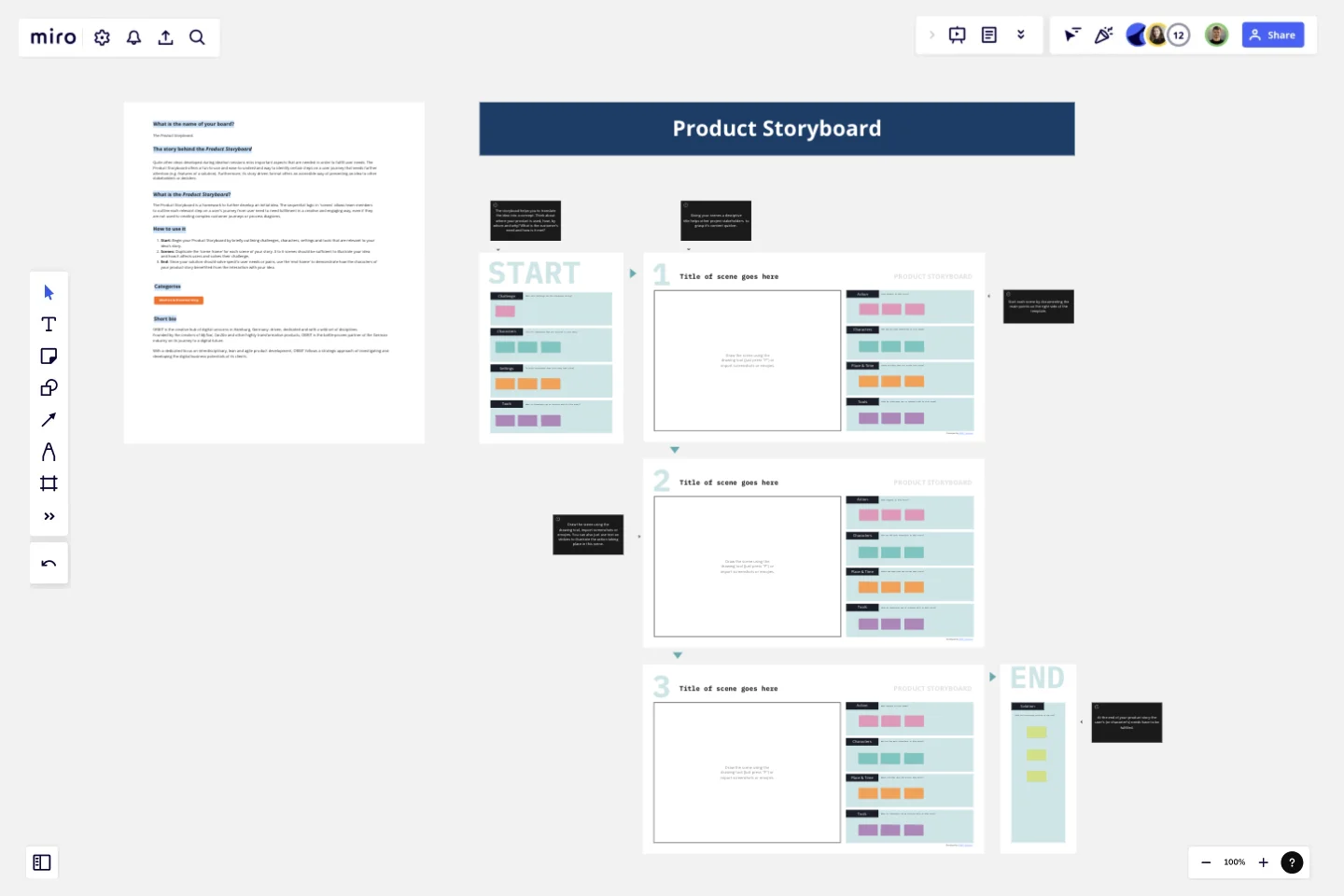The Product Storyboard
Quite often ideas developed during ideation sessions miss important aspects that are needed in order to fulfill user needs.
The story behind the Product Storyboard
The Product Storyboard offers a fun-to-use and ease-to-understand way to identify certain steps on a user journey that needs further attention (e.g. features of a solution). Furthermore, it's story-driven format offers an accessible way of presenting an idea to other stakeholders or deciders.
What is the Product Storyboard?
The Product Storyboard is a framework to further develop an initial idea. The sequential logic in 'scenes' allows team members to outline each relevant step on a user's journey from user need to need fulfilment in a creative and engaging way, even if they are not used to creating complex customer journeys or process diagrams.
How to use it
Start: Begin your Product Storyboard by briefly outlining challenges, characters, settings and tools that are relevant to your idea's story.
Scenes: Duplicate the 'scene frame' for each scene of your story. 3 to 6 scenes should be sufficient to illustrate your idea and how it affects users and solves their challenge.
End: Since your solution should solve specific user needs or pains, use the 'end frame' to demonstrate how the characters of your product story benefitted from the interaction with your idea.
This template was created by Nono Weinzierl. Discover more storyboard template examples and map your next project.
Get started with this template right now.
Roadmap Mountain
Works best for:
Roadmap, Planning, Mapping
The Roadmap Mountain template provides a metaphorical framework for planning and visualizing project objectives and milestones. By depicting the journey towards achieving goals as a mountain ascent, teams can inspire motivation and focus. This template encourages collaborative goal-setting and fosters a sense of accomplishment as teams progress towards their summit. With clear milestones in sight, teams can stay motivated and track their progress effectively.
Salesforce Implementation Plan
Works best for:
Roadmap, Planning, Mapping
The Salesforce Implementation Plan template offers a structured framework for planning and executing Salesforce deployment projects. By outlining key milestones, tasks, and dependencies, teams can ensure a smooth transition to the Salesforce platform. This template facilitates collaboration between IT and business teams, ensuring that implementation efforts are aligned with strategic objectives and deliver value to stakeholders.
Design Research Template
Works best for:
UX Design, Design Thinking, Desk Research
A design research map is a grid framework showing the relationship between two key intersections in research methodologies: mindset and approach. Design research maps encourage your team or clients to develop new business strategies using generative design thinking. Originally designed by academic Liz Sanders, the framework is meant to resolve confusion or overlap between research and design methods. Whether your team is in problem-solving or problem space definition mode, using a research design template can help you consider the collective value of many unrelated practices.
Product Roadmap (Now, Next, Later, Trash)
Works best for:
Planning, Mapping
The Product Roadmap (Now, Next, Later, Trash) template allows teams to organize their product development initiatives into four distinct categories: current priorities, upcoming features, future plans, and discarded ideas. By visualizing the roadmap in this manner, teams can maintain focus on immediate objectives while keeping an eye on future opportunities and managing stakeholder expectations effectively.
Multiple-Product Roadmap
Works best for:
Planning, Mapping
The Multiple Product Roadmap template empowers product managers to visualize and manage multiple product initiatives effectively. By providing a centralized view of project timelines, dependencies, and milestones, this template fosters alignment and transparency across teams. With sections for prioritizing initiatives, tracking progress, and communicating updates, it enables teams to coordinate efforts and drive collective success. This template serves as a strategic tool for planning and executing product roadmaps that align with organizational goals and drive business growth.
Prioritized Product Roadmap
Works best for:
Roadmap, Mapping, Planning
The Prioritized Product Roadmap template enables teams to focus on delivering the most valuable features to customers. By prioritizing initiatives based on impact and effort, teams can maximize the return on investment and drive business value. This template fosters collaboration and alignment, ensuring that development efforts are aligned with strategic objectives and customer needs.
